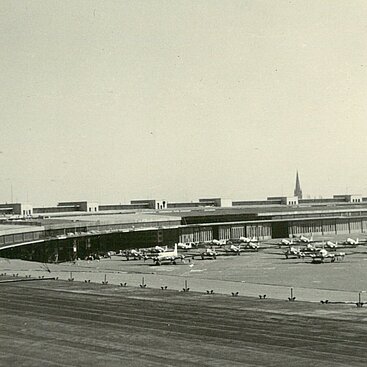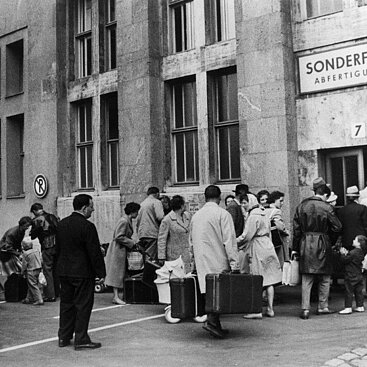Forced labourers
The Second World War, which began in September 1939 with Germany’s attack on Poland, prevented the completion of the construction of Tempelhof airport. The existing building became a strategic location of the German aircraft construction and the eastern area of the new airfield became the barracks camp for forced labourers from occupied countries.
Arms production in the Airport Tempelhof
According to an arrangement of the Reich Air Ministry as on December 1939, “Weser” Flugzeugbau GmbH, whose main factory was overloaded due to extensive war production and was located in the north coastal region of Germany unprotected from air raids, relocated parts at first and then the main part of its aircraft production from Lemwerder to Berlin-Tempelhof. Here, the aircrafts could likewise arrive and start on the airfield. The new dive bomber Ju 87, a light bomber, specialised in dive attacking point targets, was manufactured in the production centre. Looking back over the NS period, the “dive bombers” are closely connected with the beginning of Second World War and the “Blitzkrieg” strategy and later with the defence of Soviet tanks drawing ever closer. Besides, modifications and repairs were made to warplanes on a large scale on the Tempelhof airport grounds.
The “Weserflug” was part of the major company in Bremen “Deutsche Schiffs- und Maschinenbau AG” (Deschimag), which also converted its production into the construction of war vessels. Hermann Göring, Reich Air Minister and the commander-in-chief of the Air Force, played a key role in the production relocation of “Weserflug” to Tempelhof: as chief of the entire airport grounds now converted into a “military airfield” and as the purchaser of the “dive bombers”. His cousin and close confidant Herbert L.W. Göring was the chairman of the supervisory board and major shareholder of “Weserflug”.
In January 1940, the plant in Berlin at first took over the halls and other buildings of the old airport. A short while later, they obtained the giant hangar and the airport gate facility of the new building and its basement. Production lines and conveyor belts for series production were set up in the eastern halls and at the airport gate A, which mainly served in production of individual parts. These included office rooms and workshops partly set up in the hangars. Around 2000 “dive bombers” built here and tested on the airfield stood in the production centre mainly in the years 1943/44. Moreover, warplanes of other types were built, converted and repaired.
Deutsche Lufthansa AG relocated its air traffic to Rangsdorf near Berlin at the beginning of the war and at first used the old airport and then the two halls of the new building for repair work on warplanes. Since 1940, it installed the radar “Würzburg” here, which was used for the defence of air raids till the end of the war.
Forced labour
More than two thousand foreign workers were employed in “Weserflug” on the Tempelhof airport in 1944, most of whom were forced labourers from occupied European countries, in the beginning often still recruited and later forcibly relocated here. Like the German aviation industry, “Weserflug” had demanded and employed particularly energetic foreign workers, mainly from occupied Poland; other production areas followed. Without foreign forced workers, the Nazi war economy and provision for German population collapsed not later than 1942; they replaced the men at the front - as skilled workers as well as workers at the conveyor belt in the rapidly expanding arms production as well as agriculture and handicrafts. From December 1938 to the end of 1943, a large number of Jews were also forced to work, who were made to undertake “private work”. They were predominantly employed in the armament factory. In the year 1941, around 20000 Jews worked in Berlin in companies relevant to the war while the Jewish population of Berlin, who could escape to foreign countries, were deported in East European ghettos and extermination camps.
The first foreign workers of “Weserflug” were women from Poland in the autumn of 1940; in 1941 French prisoners of war and civilians followed, primarily skilled workers from France, Italy, Netherlands, Belgium and Czechoslovakia and from 1942 onwards forced labourers (“Eastern workers”) and prisoners of war from the Soviet Union. Since the beginning of war, complete Germany was occupied by forced labourers. In 1944, there were more than 1000 camps for more than 400 000 men and women from more than twenty nations in Berlin alone. A large barrack facility was built for “Weserflug” at the northern edge of the Tempelhof field.
Even Deutsche Lufthansa employed forced labourers from occupied countries in its workshops and during the installation of radars for maintenance and repair of front aircrafts and accommodated them in barracks on the premises. Especially for serial installation of radars, it employed forced Jewish labourers in the years from 1940 to 1942.
Working and living conditions
The work was hard and the work pressure extreme. The changing day and night shifts lasted at least twelve hours; holidays promised to recruited “free civilian foreigners” were mostly cancelled. “Non-free civilian foreigners” mainly from occupied East European countries had to work for much longer - many times up to 36 hours. They were at the mercy of their superiors’ despotism and received very low or no payment. If they opposed, they would be beaten, examined by Gestapo and often confined in a “labour training camp”. The forced labourers were mostly accommodated in a large repeatedly expanded complex of barrack camps, which was built immediately next to the new airport building. Four of the finally almost twenty accommodation barracks were used by “Deutschen Lufthansa”; these included canteen and sick barracks. A smaller barrack complex of “Weserflug” was located further south of the Tempelhofdamm. Dressing barracks for Jewish forced labourers were located to the east of the old airport building and the only toilet that they were allowed to use was one kilometre from away the new building halls.
The barrack camp was enclosed with barbed wire and was monitored using machine guns and floodlights. The East European civilian workers were also locked, who were promised freedom at work during recruitment. Moreover, different groups within the camp were separated from one another using a fence. They lived in extremely confined spaces and slept on straw mattresses in bugged wooden beds. The food was not enough to keep up strength. Many would become ill but were given insufficient medication or none at all.
End of war
Heavy air raids after the end of 1943 destroyed the barracks and the old airport building; on the contrary, the new building remained largely intact owing to its steel and reinforced concrete construction. The “Weserflug” relocated different production areas to tunnel and underground railway facilities above and beside the airport facility; during the year 1944, production and forced labour were largely relocated to other regions i.e. in the underground facilities in Bohemian Rabstein, where KZ prisoners were also employed. However the operation in Tempelhof fully stopped not before 25 April, a few days before the capture of the airport by the Soviet troops.
The long-awaited return after the liberation was linked to frustration and deprivation for the East European forced labourers and prisoners of war. Their suffering found no public sympathy. In Stalinist Soviet Union, surviving in the German Reich was equivalent to collaboration with and betrayal of the “Great Patriotic War”. Many suffered from physical and psychological consequences of forced labour all their life. The Federal Republic compensation payments often came too late and were hardly more than just a sign of recognition. Since the 1990s, historians of Berlin history workshop have researched the history of the “forgotten camps” and attempted to establish contacts with the survivors. Since 2006, the documentation centre of NS forced labour in Berlin-Schöneweide has offered more information about the location of the only barrack camp in Berlin.
St. Endlich, M. Geyler-von Bernus, B. Rossié
Literature
Lutz Budraß, Lufthansa and its foreign workers in Second World War, editor: Deutsche Lufthansa AG, Frankfurt am Main 2001
Matthias Heisig, The deployment of foreign forced labourers for “Weser” Flugzeugbau GmbH at the Airport Tempelhof in 1940-1945. In: Workshop of Berlin regional museums (editor), Forced labour in Berlin 1938-1945, Berlin 2003
F.-Herbert Wenz, Airport Tempelhof. Chronicles of the Berlin workshop of “Weser” Flugzeugbau GmbH Bremen, Lemwerder 2000





